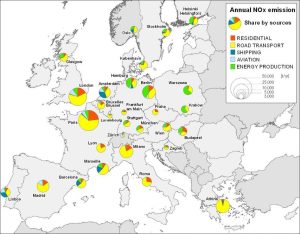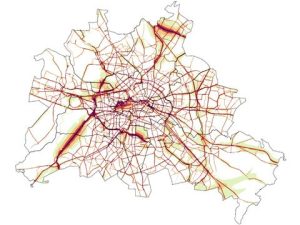The air we breathe as we move through the chaos of city life is frequently contaminated by emissions. The vast majority of these come from the exhaust tailpipes of motor vehicles circulating on our cities’ streets. Even though greenhouse gas emissions by motor vehicles (which contribute significantly to climate change) get the lion’s share of attention, another category, that of air pollutant emissions, is responsible for severe health-related problems and premature deaths. Exposure to pollutants such as particulate matter, benzene, nitrogen oxides, and carbon monoxide has been linked to respiratory problems, cardiovascular diseases, and an increased risk of lung cancer.
Children, the elderly, and individuals with pre-existing health conditions are particularly vulnerable. Due to the proximity of urban populations to road traffic, the related air pollution was generally regarded as the highest environmental public health risk, still claiming prematurely 238,000 lives in the EU every year.

Image 1: Share of different sectors in NOx emissions in various European cities. (Source: EC JRC, 2019)
If air pollution represents the highest environmental public health risk for urban populations, then it is certainly not the only one. Life in the city has always been associated with the background noise of urban activities. However, the ubiquitous noise produced by road traffic is not simply annoying; it also presents a serious risk to human health. Research on the detrimental consequences of noise pollution on urban populations is growing.
The constant cacophony of engine roars, exhaust pipe noises, tyre screeches and noise from illegally tempered vehicles has been connected to sleep disturbance, cardiovascular and metabolic disease, adverse birth outcomes, cognitive impairment, poor mental health and well-being, and premature mortality.
In 2018, more than 48% of the EU’s urban inhabitants were exposed to noise levels exceeding the WHO-recommended threshold of 53 decibels, resulting in 48,000 new cases of ischemic heart disease and 12,000 premature deaths from noise pollution every year.

Berlin’s Road Traffic Noise Map. (Source: Berlin Environmental Atlas, 2022)
Light vehicles (LVs) might be a quick, effective, and seemingly less disruptive form of road transportation. However, when it comes to the general public’s health, there are significant drawbacks to their small size and agility. Frequently seen speeding through urban streets, LVs greatly aggravate air and noise pollution in urban areas, as showcased by recent studies featuring on-site measurements on the streets of Southeast Asia. When compared to those of bigger vehicles, the smaller engines of LVs frequently (and surprisingly) produce more pollutants per kilometre, which raises the concentration of dangerous compounds in the air.
Moreover, the high levels of noise pollution observed in the vicinity of urban streets are frequently caused by the characteristic roar of motorbike engines and the loud noises produced when they honk, attaining levels similar to or even higher than that of medium-duty trucks and rail freight, as suggested by a data comparison compiled by the International Union of Railways (UIC). The LENS project aims to assist in the minimisation of both air and noise pollution by LVs, by conducting both lab tests and on-site measurements on European streets, to create a set of possible recommendations and interventions, ranging from new policy regulations and technical interventions to enforcement methods and user behaviour changes.
Further reads:
- Grubesa, S., & Suhanek, M. (2020). “Traffic Noise” in Noise Pollution. Publisher: INTECHOPEN LIMITED, London (UK)
Is my car bad for the environment? A guide to vehicle exhaust emissions
- Lancet Planetary Health: Premature mortality due to air pollution in European cities: a health impact assessment
INTER-NOISE and NOISE-CON Congress and Conference Proceedings
Real-world emissions of gaseous pollutants from motorcycles on Indian urban arterials

